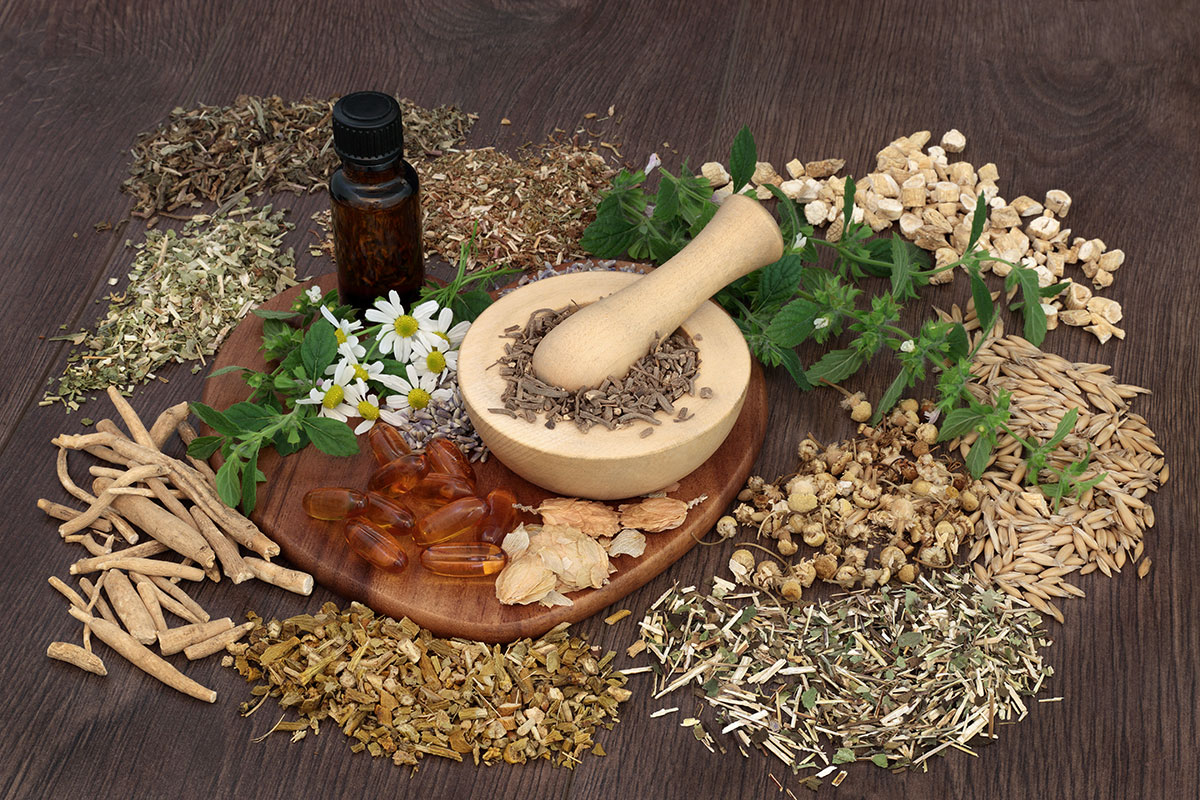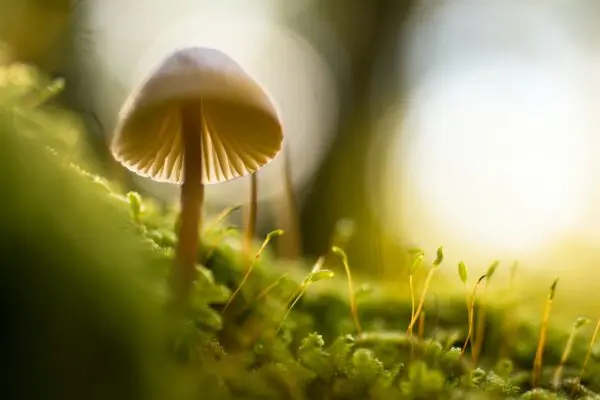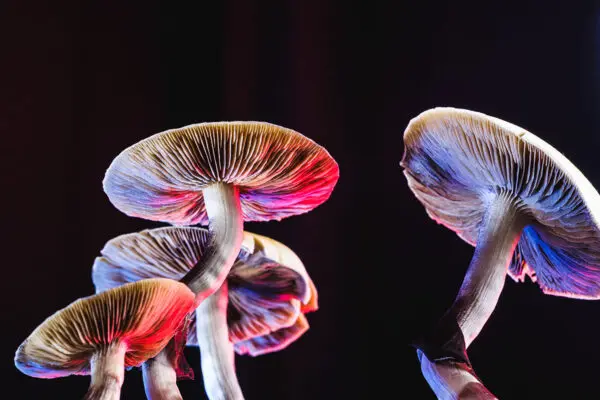Reishi Strauss is an Appalachian-born herbalist and mycologist now based in the Pacific Northwest, where she attended Bastyr University and received her Bachelor’s of Science in Herbal Science. A lover of the intersections between science and spirit, Reishi has taken courses in pharmacology, ethnobotany, herb/drug interactions, the history of herbal medicine, and more. Reishi is also passionate about utilizing plant and mushroom medicines in a way that is respectful and reciprocal to the Earth and the indigenous communities who steward them. Reishi owns and operates her own medicinal mushroom business out of her yurt on Orcas Island called Earth & Spirit Botanicals. You can access the medicines she creates here.
Leia: I know that bitter medicine is sometimes considered the most potent medicine. That being said, eating mushrooms can be a challenge! What is your advice to people who are looking for different ways to consume magic mushrooms?
Reishi: If the taste and texture of consuming dried magic mushrooms is unpleasant for you, you’re not alone! There are some other delicious ways to get this medicine in your system. Some of my favorites include making mushroom tea and chocolate mushroom truffles.
Leia: How do you make shroom tea, and what are the benefits of that method?
Reishi: Mushroom tea might be one of the most straightforward and easy ways to consume mushrooms. It is often easier on the digestive system as you’re only consuming the aqueous extract of the mushroom, instead of the dried mushroom itself. There have also been reports that mushroom tea is less likely to induce nausea than consuming the raw mushrooms themselves.
The first thing you’re going to want to do is powder your dried mushrooms. When making any sort of herbal extraction, you’re going to want to maximize the surface area between the substance you’re extracting (mushrooms) and the solvent (water) to increase absorption. One of the easiest ways to grind your mushrooms will be in a coffee grinder, cannabis grinder, or a good blender.
After your mushrooms are powdered, weigh out the dosage. Generally, beginners will want to start out somewhere between 1-2 grams. More experienced journeyers could go up to 4 or 5 grams.
Once you weigh out your dosage, put them in a jar and pour hot water over them. Let the mushrooms steep in the hot water for 10-15 minutes and then drink the tea!
The effects of the mushroom tea can come on much more quickly than eating raw or dried mushrooms whole. Since you’re extracting the mushrooms ahead of time in the water, your digestive system won’t need to do as much work to break down and absorb the substance. This has the added benefit of being easier on your digestive tract but can sometimes make the mushrooms come on stronger and more quickly.
If you decide to make the tea, consider approaching it as a ritual. Try bringing intention to the process of powdering the mushrooms, heating the hot water, steeping, and drinking the tea. This mindfulness could serve as a grounding exercise to prepare you for the experience that lies ahead.
After the tea is steeped, you can strain the mushroom powder using a coffee filter or cheesecloth and drink the remaining liquid. Although this is more helpful for reducing symptoms of nausea, you might get a stronger effect if you mix the mushroom powder in with the unstrained tea and drink it together. Choose your own adventure 🙂
Leia: I’m a big fan of bringing intention to psychedelic journey work, so I love that idea. What about the chocolate mushroom truffles, how you make those, and what are the benefits?
Reishi: Chocolate and mushrooms have been an ancient combination used by Mesoamerican cultures for thousands of years due to the synergistic medicinal effects and delicious flavor combination of mushrooms and cacao. The strong, earthy, rich taste of chocolate tends to match and harmonize with the earthy taste of the mushrooms, creating a more delectable experience. I love using this recipe for Dark Chocolate Energy balls from the Minimalist Baker, and substituting 3 tsp of mushroom powder for the hemp seeds.
The benefit of this method is that they’re DELICIOUS! Chocolate and mushrooms are a wonderful combination, not only for their flavor but also for the energetics.
Leia: What are the energetic benefits of combining chocolate and mushrooms?
Reishi: Chocolate is a tried and true classic combination with magic mushrooms. The pods from the chocolate tree, better known as Cacao, can dilate our arteries and help to circulate the medicine through our entire system, particularly the vasculature around our heart. Cacao can make our mushroom journey more of a heart-centered, emotional experience. You can read more about this combination here.
Leia: Sweet! Are there other good herbal combinations to try with magic mushrooms?
Reishi: The art of combining mushrooms with other herbal medicines is a ton of fun! Here are some popular herbal combinations to try:
Lemon: The citric acid in lemons makes the psilocin in magic mushrooms more bioavailable and readily available for your body to uptake. If you’re desiring a stronger, shorter mushroom journey, combining your mushrooms with citrus could be a fun experiment. Simply add the juice of 1-2 lemons to your powdered mushrooms, let them sit for 15-20 minutes, and then proceed as above and make your mushroom tea with the powdered mushroom and lemon juice mix.
Ginger (Zingiber officinale): This is a wonderful herbal combination to try if you’re concerned about the digestion and nausea part of the mushroom experience. Although making mushroom tea will likely reduce this possibility, adding ginger is another step to making sure that these symptoms don’t occur.
In herbal medicine, ginger is known for reducing nausea, promoting digestion, and reducing gas and spasms in the digestive tract, making bloating and digestive pain less likely. Try boiling sliced ginger root in water for 15 minutes, then using that same boiled ginger tea water to make your mushroom tea. You can also take ginger in the form of capsules or candies.
Lavender (Lavandula angustifolia): Sometimes, a magic mushroom journey can be an intense experience for the nervous system. This isn’t “good” or “bad,” it’s just that mushroom journeys can bring up a lot of sensations, experiences, and realizations for your system to process. That’s why I love combining magic mushrooms with calming herbal remedies, both before, during, and after the journey.
One of the most accessible ways to do this is by using lavender essential oil, simply through inhalation, dripping it onto your clothes, or diffusing it into the space you’re inhabiting during the experience. You can also mix your powdered mushrooms in with a tablespoon of lavender buds and steep everything together for a lavender mushroom tea. I recommend sweetening it with a bit of honey.
Leia: Thank you for these great suggestions! One last question on the topic of herbalism. I’ve heard people say that they “work with plant medicine.” Usually, they mean that they take psychedelics such as psilocybin-containing mushrooms, ayahuasca, San Pedro cactus, or cannabis in a healing capacity. And, they aren’t wrong! These are all powerful plant medicines.
But I think there is an issue of psychedelic exceptionalism where psychedelics are considered superior to other herbs and fungi. Have you noticed this? Do you think some people should open up their horizons and include other healing, non-psychedelic herbal and fungi medicines into their practice of self-care and healing?
Reishi: Absolutely! I love this question a lot. I think there is definitely a hyper-focalization on psychedelic plants in the world of people who “work with plant medicines.” Traditionally, the medicine men/women of indigenous cultures were knowledgeable about the properties of all different types of plants. The shamans who steward the wisdom traditions of peyote, ayahuasca, mushrooms, San Pedro, and other psychedelic plant medicines also worked very closely with other plant medicines in their ceremonies and healing practices. They were familiar with the vast array of medicinal plants and studied their powers and secrets.
Because of Western society’s medical paradigm with pharmaceuticals, a lot of people are used to taking a substance one time and immediately feeling the effects. Quick-fixes such as pain relievers and surgery, coupled with the “instant satisfaction” consumerism brought by the age of industrialization, have all contributed to a collective drop in our sensitivity and dedication to slow and subtle ways of being. The ways that most plants communicate, however, is not through an immediately perceptible and obvious shift. Their medicine can be much more subtle and can take time to develop a sensitivity to.
Just like doing yoga, you aren’t going to get the majority of the benefits if you only take one yoga class. You need to keep showing up, day after day, and see how devotion and dedication to the practice can gradually change your body and mind. I feel the same with non-psychedelic plant medicines … the more we connect with them, day after day, and observe their effects on our body and mind, the more we can understand their special effects.
In reality, all plants can feel “psychedelic” if we take the time to truly tune into their energetics and effects on our bodies and minds. And then it can be a REALLY amazing and special experience to combine these “non-psychedelic” plants with more traditionally psychedelic plants, to get to know them on an even deeper level.









